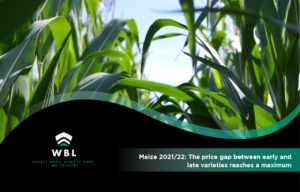Maize 2021/22: The spread between Early and Late Corn reaches a maximum
Although the 2021/22 maize plantings have already started, the threat of a Niña event leads to a greater proportion of the lots going to the late segment. With this, the premium for April maize concerning delivery in July reaches a maximum.
Maize 2021/22 is looking to be the big star of the new campaign. With an area growth of more than 7% compared to the current season, the first projections foresee a record production of more than 56 Mil MT. Faced with these expectations, the early planting has already taken off in a large part of the country, having already covered 26% of the planting intention area. Furthermore, in the last week, the work intensified and both the pace of the previous season and the average of the last five years were exceeded.
However, the new campaign poses a threat when it comes to the climate issue. The possibility of a new Niña year grew over the months and, according to the latest IRI report, the highest probability of a Niña event would occur in the Nov-Dec-Jan quarter.
Whether a year is a Niño or Niña depends on the temperature of the water surface in the region of the Pacific Ocean that is at the height of the Equator. When the water temperature is warmer than normal, it is in the presence of an El Niño year, which is usually associated with higher rainfall and lower temperatures in southern Brazil and much of the productive region of north-central Argentina. Meanwhile, when the water in that region of the Ocean is colder than normal, we are facing a La Niña year, a global phenomenon that is associated with rainfall below normal and warmer temperatures in the case of our country.

In any case, at least in principle, the intensity of the Niña phenomenon in the coming months would be moderate. In August and September, the water surface temperature in that Pacific region was above the records for 2020. Likewise, the projections for the coming months also show that the intensity of the phenomenon would not be so marked.
In addition, it is also necessary to emphasize that what happens with the Pacific is a global climate phenomenon, which is why it influences all regions of our planet, but it is not the only determinant of climate. There are also regional phenomena that can provide moisture regardless of the situation in the Pacific. For example, the Atlantic Ocean can make its own moisture contributions to the region. However, one of the main drawbacks is that the temperature of this ocean is more volatile, so it is not possible to foresee the contribution it will make in the medium term.
In any case, in the face this lower-rains scenario, it is expected that a greater proportion of lots will be sown with Late Corn varieties, whose harvest occurs in the July/August two-month period, to the detriment of Early Planted Corn, whose threshing occurs mostly in March-April. Like what happened with 2020/21, this is based on the fact that a large number of producers would delay their plantings to prevent their crop from going through its critical flowering period at the same time we are to expect the harshest part of the Niña phenomenon. This strategy has been successful in the last season: the yields of late and second-crop maize were higher than expected, which pushed productivity at the national level 3 quintals above the average of the last five years.
However, this affects the time of year when there is a greater volume of grains coming into the market, which has an impact on prices. This year, like the previous one, the spread between early maize prices and late planted maize has skyrocketed. Based on the prices offered in the cash market of the Rosario Stock Exchange, taking the prices offered for delivery in April as indicative of the early and those offered for delivery in July as indicative of the late, we can see that the spread between both segments is at the highest levels in at least five years, even exceeding the spread it registered this time last year.
Taking the period between the end of September and the beginning of October for the last five seasons, the average differential between the prices offered for the new season was 14.3 USD/MT, exceeding last year’s average spread. In addition, another remarkable aspect is that in previous years, when the climatic situation was favorable at the time of planting and not many producers opted for planting late maize, the price differential was considerably below its current values.
Trying to project the analysis over time to see how this spread has behaved in previous years, we can use the Matba-Rofex futures contracts. Taking the maize contract for delivery in Rosario city in April and July of each year as reference of the prices of early and late maize, respectively, we can see that the price differential in favor of early maize has been this year at maximum levels for the time of year relative to previous years.
Source: https://bcr.com.ar/
Photo: REUTERS/Stringer
For more info visit
https://www.linkedin.com/company/wbl-shipping-agency/
